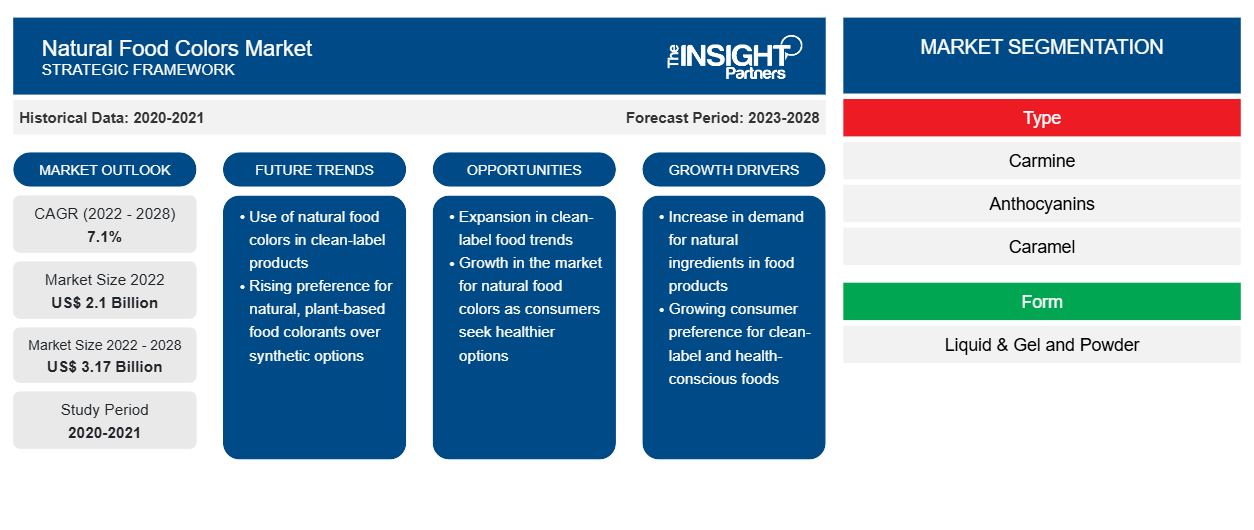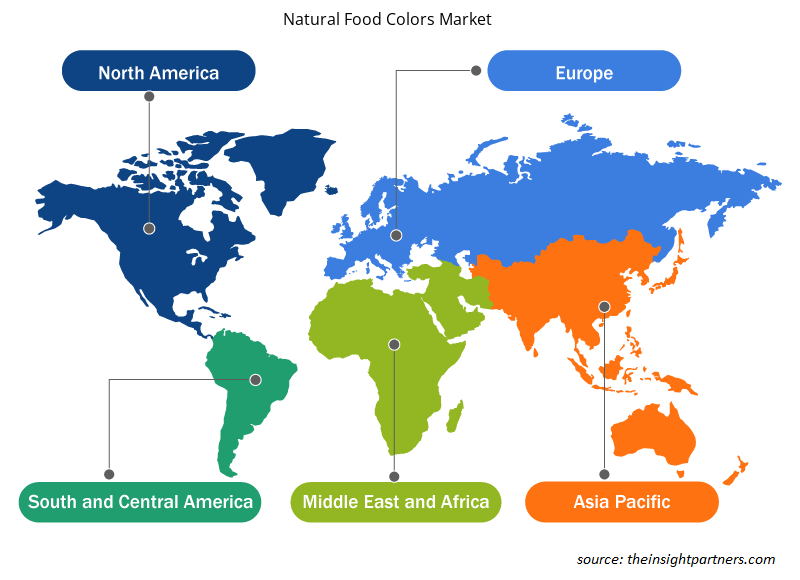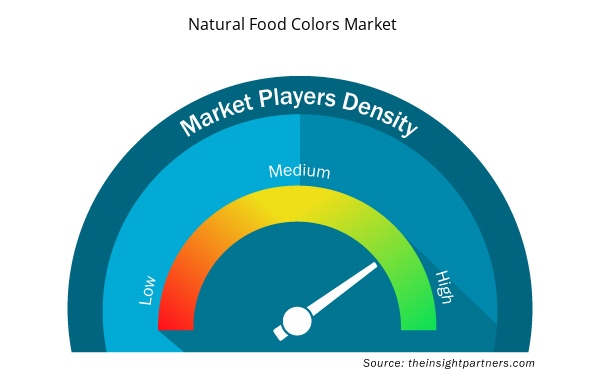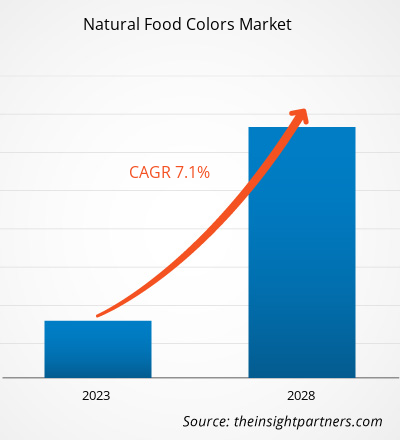[Research Report] The natural food colors market is projected to reach US$ 3.17 billion by 2028 from US$ 2.10 billion in 2022. It is expected to grow at a CAGR of 7.1% during 2022–2028.
There is an increase in demand for natural food colors, owing to increasing awareness among consumers about the harmful effects of synthetic colors and rising rules and regulations of governments regarding the use of synthetic colors. Most people nowadays have become health conscious and are opting for organic and natural products. Natural food colors are safe to consume and add to food's nutritional value. Additionally, natural food colors do not contain common allergy-prone ingredients. Instead, they contain antioxidants that reduce the risk of many diseases. All these factors are driving the market.
The market is projected to witness significant growth in the coming years due to the strong presence of prominent players such as Koninklijke DSM N.V., Sensient Technologies, and Archer Daniels Midland Company. A large variety of natural food colors have gained consumers' attention. There has been a growing trend toward consuming packaged RTE and RTC food products. This factor is projected to offer new opportunities to natural food color manufacturers during the forecast period.
In 2021, Europe held the key share of the global natural food colors market. However, Asia Pacific is estimated to register the highest CAGR in the market during the forecast period. The Asia Pacific market is segmented into China, India, Australia, Japan, South Korea, and the Rest of Asia Pacific. The food & beverages industry is one of the booming industries in Asia Pacific due to the rising population and changing eating habits of consumers. Consumers in developing countries are experiencing a sharp increase in their disposable income, raising their purchasing power. The rise in disposable income levels of consumers and the growth of the middle-class population are among the key factors driving the natural food colors market in the region.
Customize This Report To Suit Your Requirement
You will get customization on any report - free of charge - including parts of this report, or country-level analysis, Excel Data pack, as well as avail great offers and discounts for start-ups & universities
Natural Food Colors Market: Strategic Insights

- Get Top Key Market Trends of this report.This FREE sample will include data analysis, ranging from market trends to estimates and forecasts.
Customize This Report To Suit Your Requirement
You will get customization on any report - free of charge - including parts of this report, or country-level analysis, Excel Data pack, as well as avail great offers and discounts for start-ups & universities
Natural Food Colors Market: Strategic Insights

- Get Top Key Market Trends of this report.This FREE sample will include data analysis, ranging from market trends to estimates and forecasts.
Impact of COVID-19 Pandemic on Natural Food Colors Market
Before the COVID-19 pandemic, the natural food colors market growth was primarily driven by the rising demand for organic and natural food products with high nutritional value. However, the market faced hurdles during the first quarter of 2020 due to business shutdown and raw material and labor shortages. The COVID-19 pandemic led to economic recession in the initial months of 2020, which created financial difficulties for low-income and mid-income consumers.
Moreover, due to restrictions, people stayed at home and cooked at home, creating a demand for packaged food products that are easy to cook. This surged the demand for RTE and RTC food products, leading to the natural food colors market growth. Consumers also became health conscious and preferred food products that are natural and safer to consume. This fueled the market growth during the COVID-19 pandemic.
Market Insights
Increasing Consumer Proclivity Toward Clean Label Products
Many people believe that food and beverage products are healthier only when they have a label with recognizable ingredients. The food & beverages industry has entered a phase of clean label products, leading manufacturers to adopt natural food colors to gain a competitive edge. Clean label products also attract more customers, as consumers are more comfortable consuming products with known ingredients.
Consumers’ proclivity toward clean labeled products is rising due to the rise in health awareness and food adulteration. This results in consumers looking to the labels before purchasing any products. This factor is expected to be a crucial driver for the natural food colors market.
Category Insights
Based on product type, the global natural food color market is segmented into carmine, anthocyanins, caramel, curcumin, annatto, carotenoids, chlorophyll, and others. In 2021, the carotenoids segment accounted for the largest revenue share, and the anthocyanins segment is expected to account for the highest growth rate over the forecast period. Natural food colors are derived from plants, animals, and other organic materials. They are safe to consume as they do not contain allergy-prone ingredients.
Koninklijke DSM N.V., Sensient Technologies, Archer Daniels Midland Company, Döhler Group, BASF SE, Naturex S.A, Aromata Group, Givaudan, Dupont, Oterra A/S, and Mane KANCOR are among the players operating in the market. These companies provide a wide range of product portfolios for the market. The companies have their presence in developing regions, providing lucrative market opportunities. Market players are developing high-quality, innovative products to meet customer requirements.
Natural Food Colors Market Regional Insights
Natural Food Colors Market Regional Insights
The regional trends and factors influencing the Natural Food Colors Market throughout the forecast period have been thoroughly explained by the analysts at Insight Partners. This section also discusses Natural Food Colors Market segments and geography across North America, Europe, Asia Pacific, Middle East and Africa, and South and Central America.

- Get the Regional Specific Data for Natural Food Colors Market
Natural Food Colors Market Report Scope
| Report Attribute | Details |
|---|---|
| Market size in 2022 | US$ 2.1 Billion |
| Market Size by 2028 | US$ 3.17 Billion |
| Global CAGR (2022 - 2028) | 7.1% |
| Historical Data | 2020-2021 |
| Forecast period | 2023-2028 |
| Segments Covered |
By Type
|
| Regions and Countries Covered | North America
|
| Market leaders and key company profiles |
Natural Food Colors Market Players Density: Understanding Its Impact on Business Dynamics
The Natural Food Colors Market market is growing rapidly, driven by increasing end-user demand due to factors such as evolving consumer preferences, technological advancements, and greater awareness of the product's benefits. As demand rises, businesses are expanding their offerings, innovating to meet consumer needs, and capitalizing on emerging trends, which further fuels market growth.
Market players density refers to the distribution of firms or companies operating within a particular market or industry. It indicates how many competitors (market players) are present in a given market space relative to its size or total market value.
Major Companies operating in the Natural Food Colors Market are:
- Koninklijke DSM N.V.
- Sensient Technologies
- Archer Daniels Midland Company
- Döhler Group
- BASF SE
Disclaimer: The companies listed above are not ranked in any particular order.

- Get the Natural Food Colors Market top key players overview
Report Spotlights
- Progressive industry trends in the market to help players develop effective long-term strategies
- Business growth strategies adopted by developed and developing markets
- Quantitative analysis of the natural food colors products market size from 2020 to 2028
- Estimation of global natural food colors market demand
- PEST analysis to illustrate the efficacy of buyers and suppliers operating in the industry
- Recent developments to understand the competitive market scenario
- Market trends and outlook and factors driving and restraining the growth of the natural food colors market
- Assistance in the decision-making process by highlighting market strategies that underpin commercial interest, leading to the market growth
- The size of the natural food colors market at various nodes
- Detailed overview and segmentation of the market, as well as the natural food colors industry dynamics
- Natural food colors market size in various regions with promising growth opportunities
The "Natural Food Colors Market Analysis to 2028" is a specialized and in-depth study of the consumer goods industry with a special focus on the global natural food colors market trend analysis. The report aims to provide an overview of the market with detailed market segmentation.
The natural food colors market is analyzed based on type, form, application, and geography. Based on type, the global natural food colors market is segmented into carmine, anthocyanins, caramel, curcumin, annatto, carotenoids, chlorophyll, and others. In terms of form, the global natural food colors market is segmented into liquid & gel and powder. Based on application, the global natural food colors market is segmented into bakery and confectionery, dairy and frozen desserts, beverages, sauces; dressings; and condiments, RTC and RTE products, meat; poultry; and seafood, and others. By geography, the market is broadly segmented into North America, Europe, Asia Pacific (APAC), the Middle East & Africa (MEA), and South & Central America.
Company Profiles
Koninklijke DSM N.V., Sensient Technologies, Archer Daniels Midland Company, Döhler Group, BASF SE, Naturex S.A, Aromata Group, Givaudan, Dupont, Oterra A/S, and Mane KANCOR are among the prominent players operating in the global natural food colors market.
- Historical Analysis (2 Years), Base Year, Forecast (7 Years) with CAGR
- PEST and SWOT Analysis
- Market Size Value / Volume - Global, Regional, Country
- Industry and Competitive Landscape
- Excel Dataset


- Surety Market
- Energy Recovery Ventilator Market
- 3D Mapping and Modelling Market
- Data Annotation Tools Market
- Aircraft Landing Gear Market
- Microplate Reader Market
- Health Economics and Outcome Research (HEOR) Services Market
- Malaria Treatment Market
- Educational Furniture Market
- Industrial Inkjet Printers Market

Report Coverage
Revenue forecast, Company Analysis, Industry landscape, Growth factors, and Trends

Segment Covered
Type, Form, and Application

Regional Scope
North America, Europe, Asia Pacific, Middle East & Africa, South & Central America

Country Scope
Argentina, Australia, Brazil, Canada, China, France, Germany, India, Italy, Japan, Mexico, Russian Federation, Saudi Arabia, South Africa, South Korea, United Arab Emirates, United Kingdom, United States
Frequently Asked Questions
Availability of a wide range of natural food colors has allowed consumers to opt for natural food products instead of synthetic ones. There is a wide range of natural food colors that is available in the market. Newly introduced colors, and trends have increased the product portfolios of many companies. Manufacturers such as Naturex, Oterra, and Kancor offer wide range of natural food colors in the market. Growing trends of mix and match colors has also affected in increasing the range of colors. Aromata Group has recently added a range of shades range, that has many different colors used in sweet and savory applications.
Based on the application, beverages segment accounted for the highest share of the global market in 2021. The beverages industry is growing rapidly, and people are preferring beverages which contain natural ingredients.
Based on the segment type, anthocyanins is expected to be the fastest-growing segment during the forecast period. Anthocyanins possess antidiabetic, anticancer, anti-inflammatory, antimicrobial, and anti-obesity effects, as well as prevention of cardiovascular diseases (CVDs). Therefore, anthocyanins extracted from edible plants have various health benefits.
Rising consumer concerns about synthetic ingredients and increasing consumer proclivity towards clean label products are drivers of natural food colors market. Natural food colors contain antioxidants which are helpful in reducing risk of various diseases. Increasing health awareness among consumers have risen the demand for natural and organic food products.
The major players operating in the global natural food colors market are Koninklijke DSM N.V., Sensient Technologies, Archer Daniels Midland Company, Döhler Group, BASF SE, Naturex S.A, Aromata Group, Givaudan, Dupont, Oterra A/S, and Mane KANCOR.
In 2021, Europe accounted for the largest share of the global natural food colors market. The growth of the natural food colors industry is also attributed to the rising awareness regarding the harmful effects of synthetic colors. People are trying to consume organic and natural food products as they are safe and healthy for human body. This factor is driving the growth of the natural food colors market in the region.
Trends and growth analysis reports related to Food and Beverages : READ MORE..
The List of Companies - Natural Food Colors Market
- Koninklijke DSM N.V.
- Sensient Technologies
- Archer Daniels Midland Company
- Döhler Group
- BASF SE
- Naturex S.A
- Aromata Group
- Givaudan
- Dupont
- Oterra A/S
- Mane KANCOR

 Get Free Sample For
Get Free Sample For